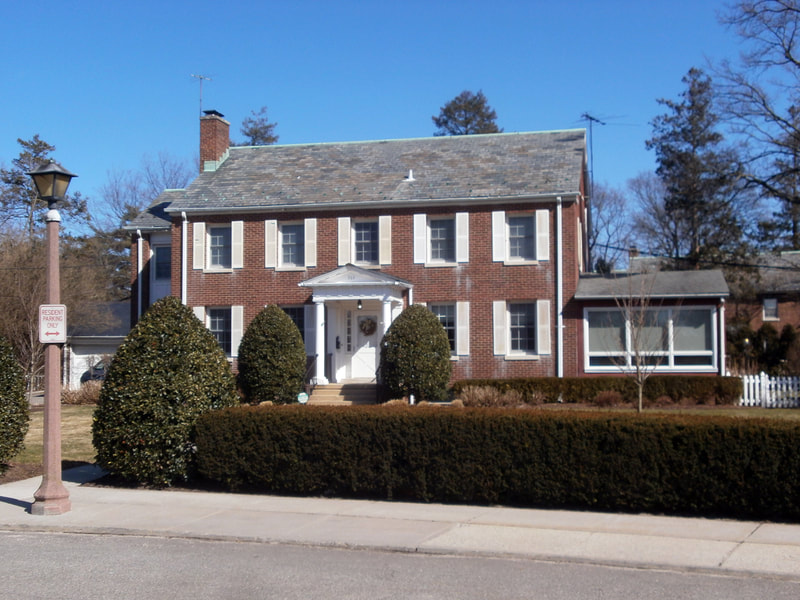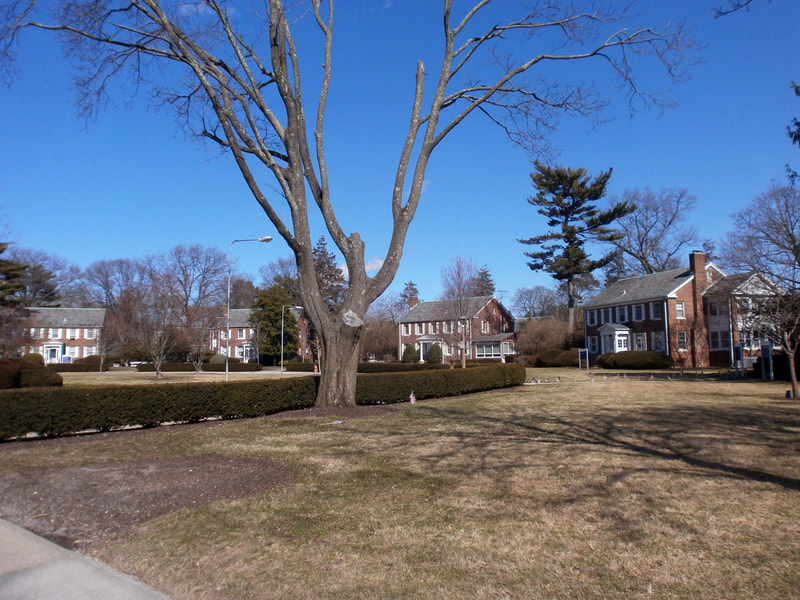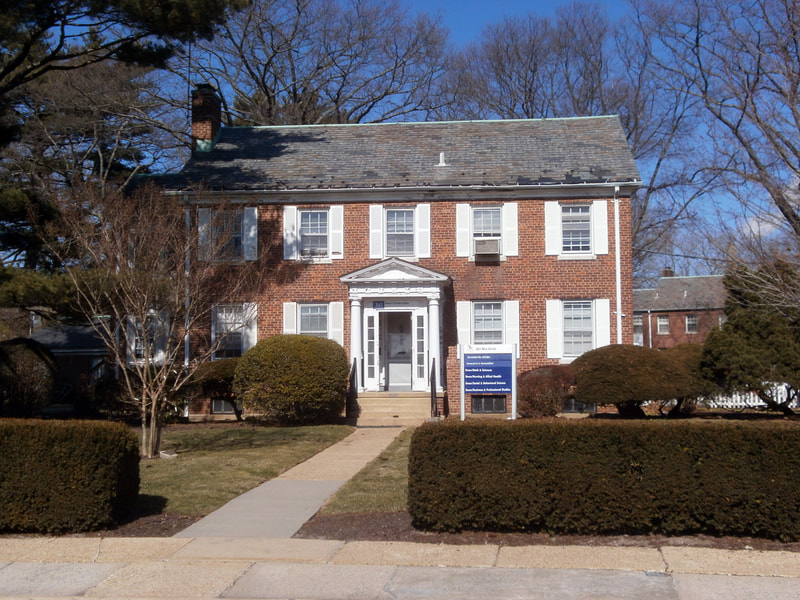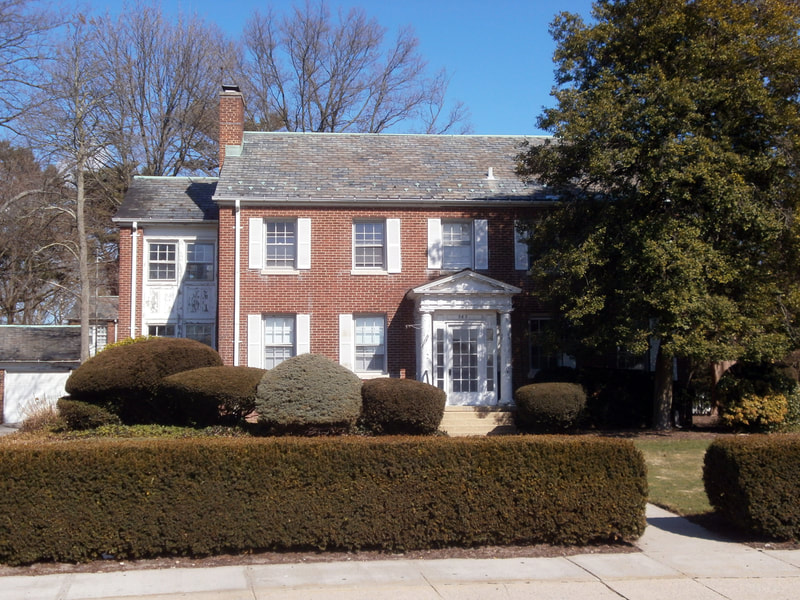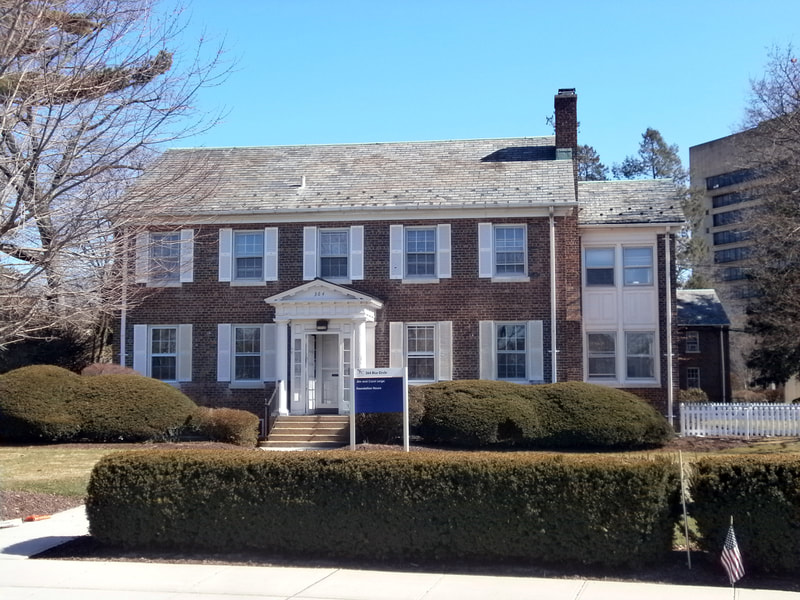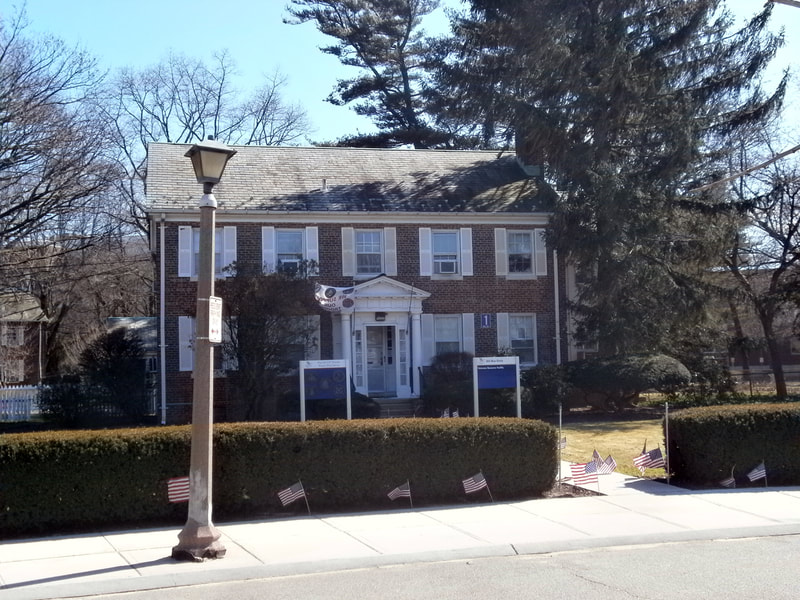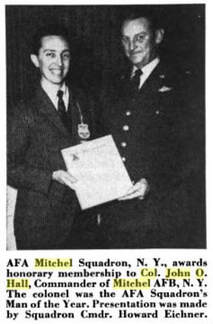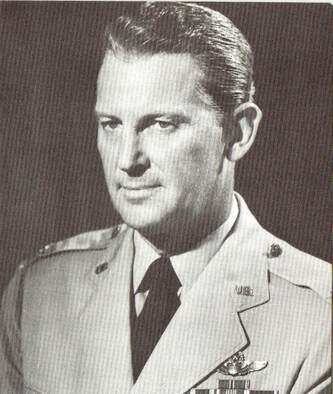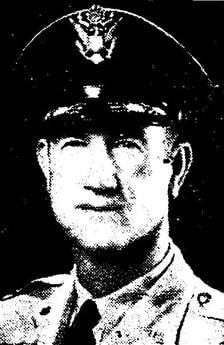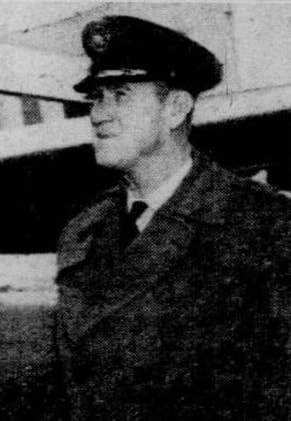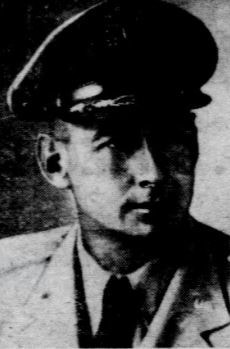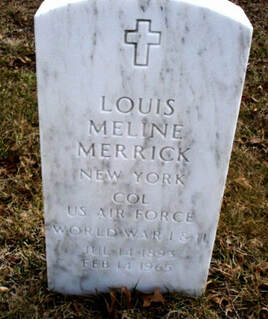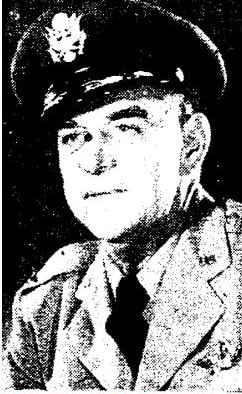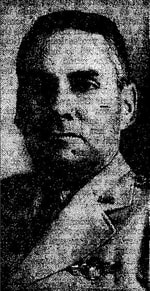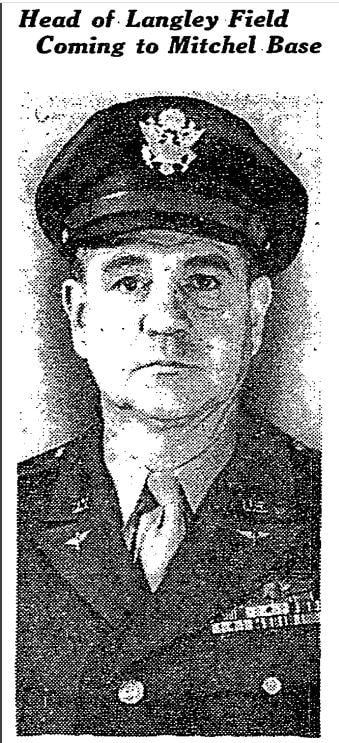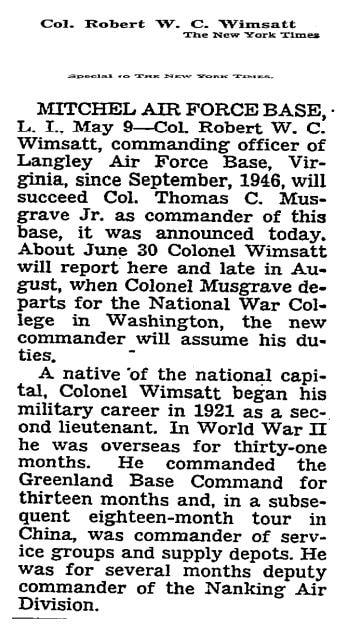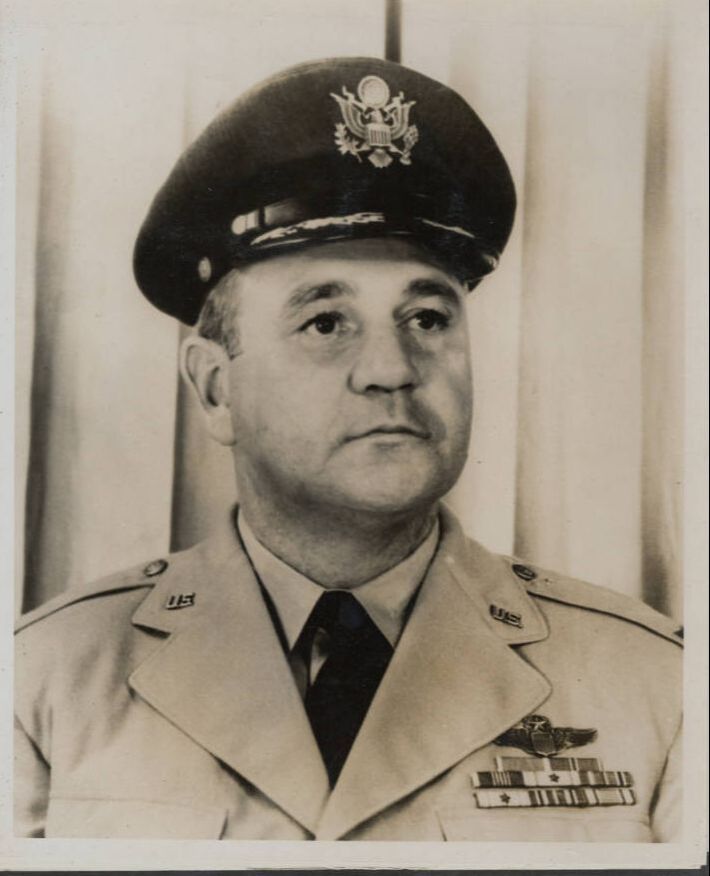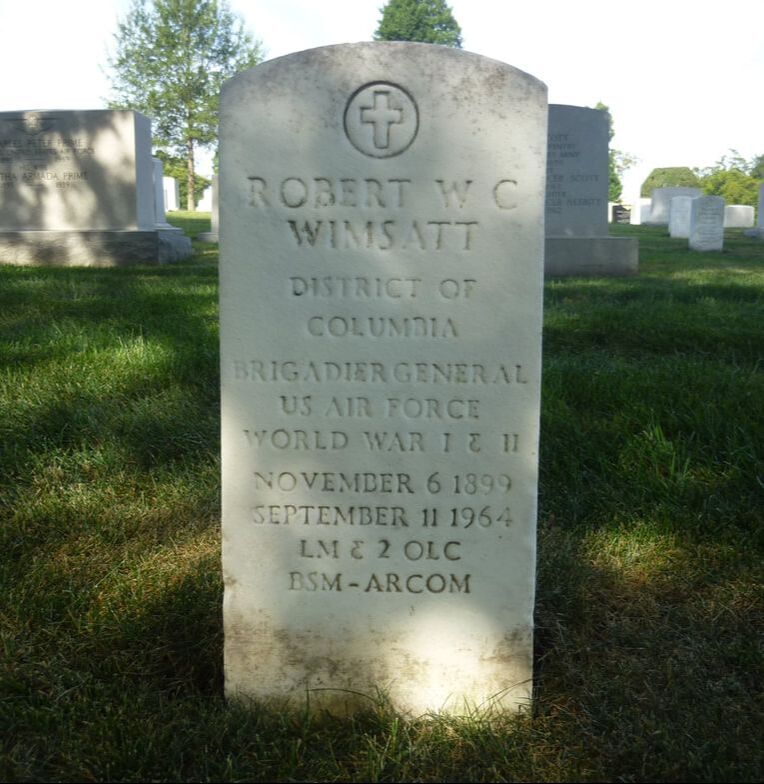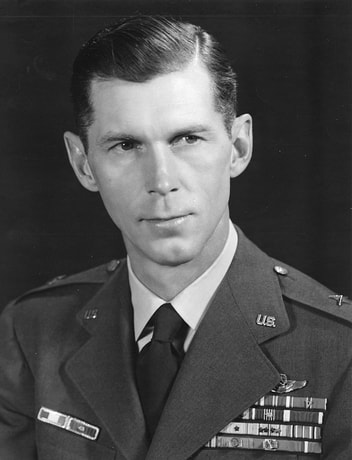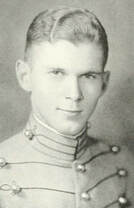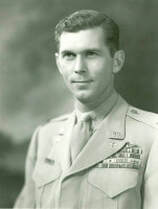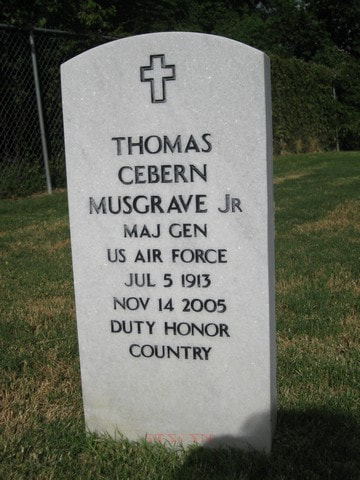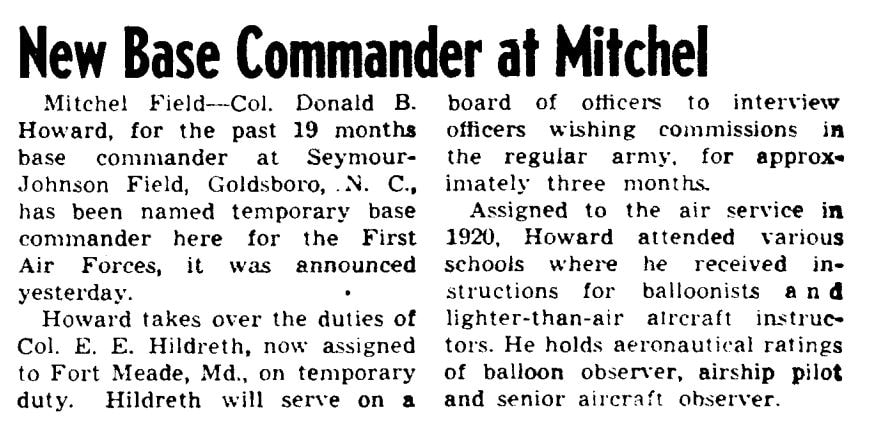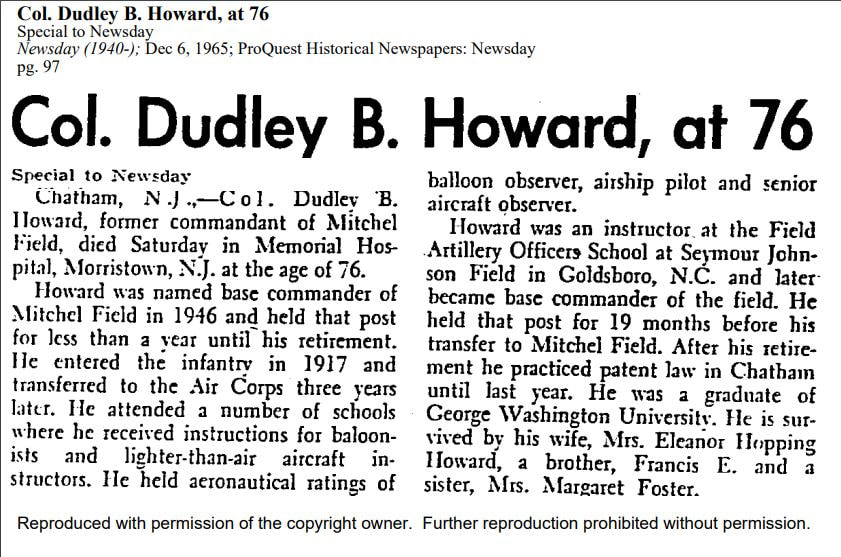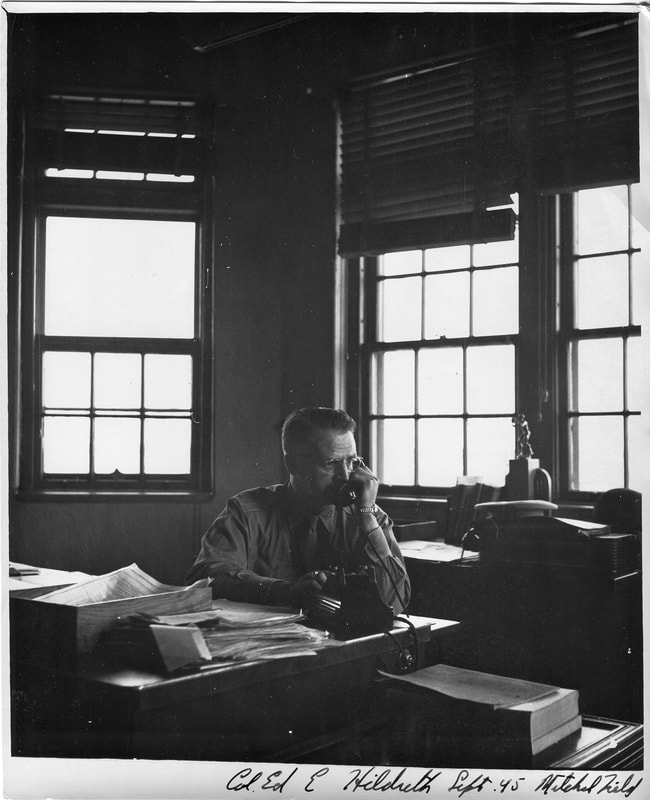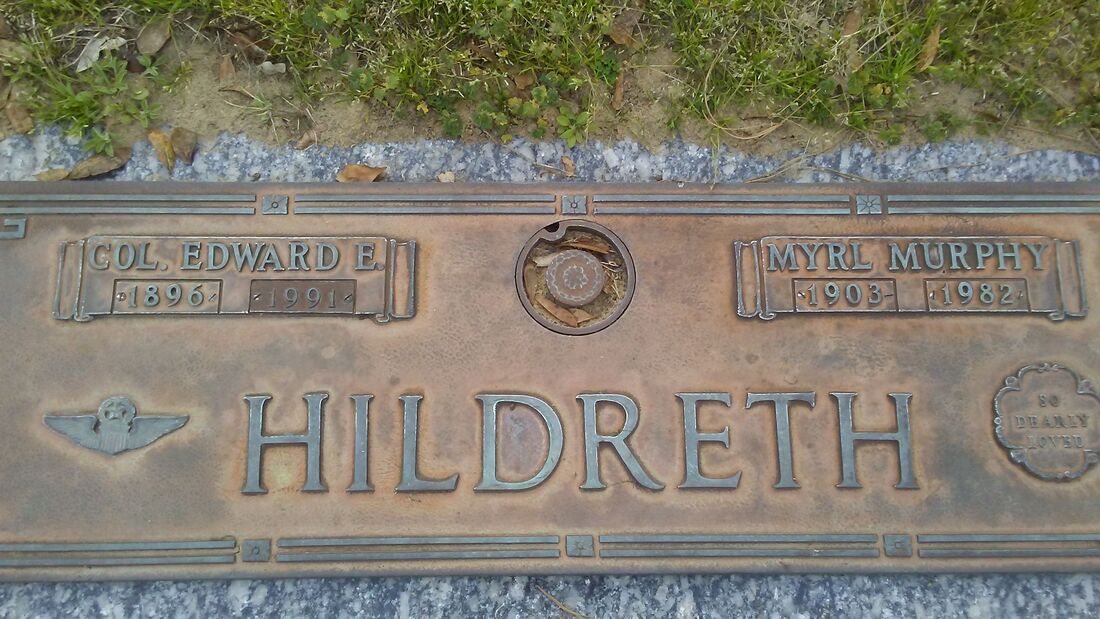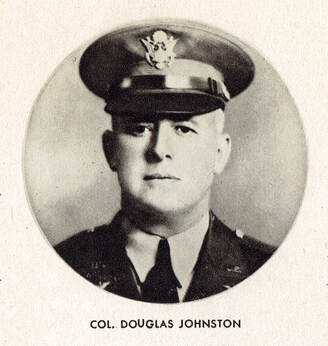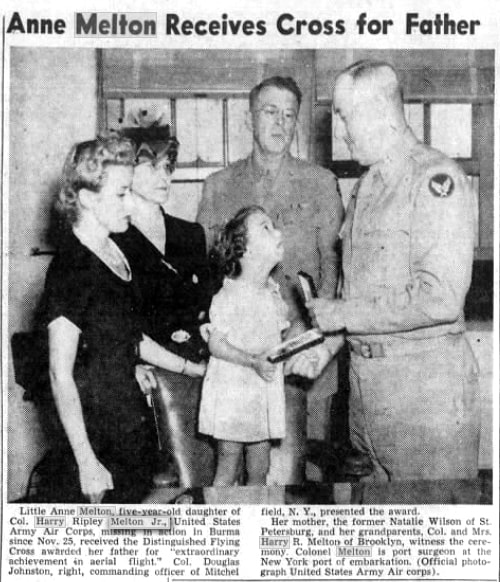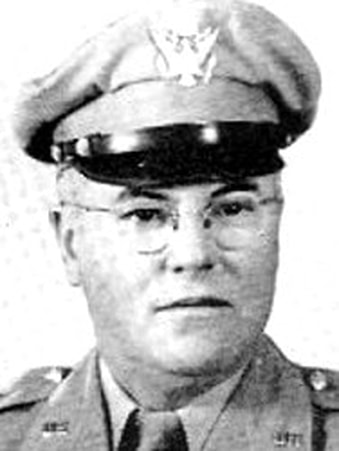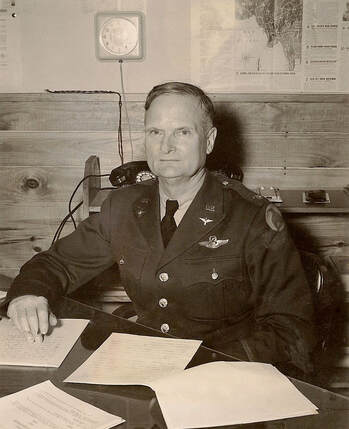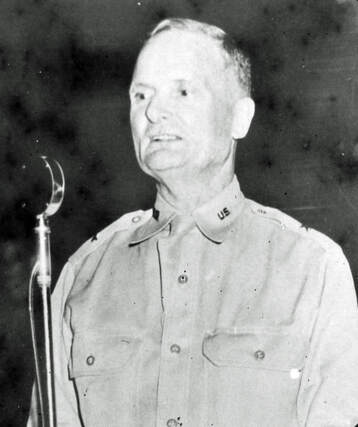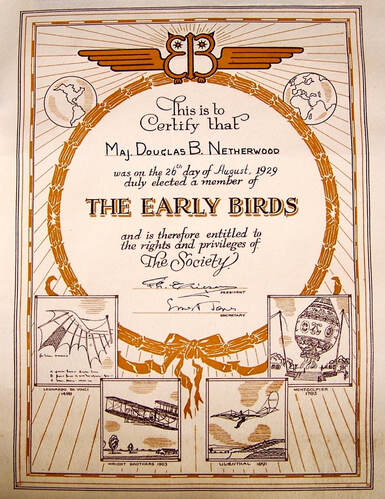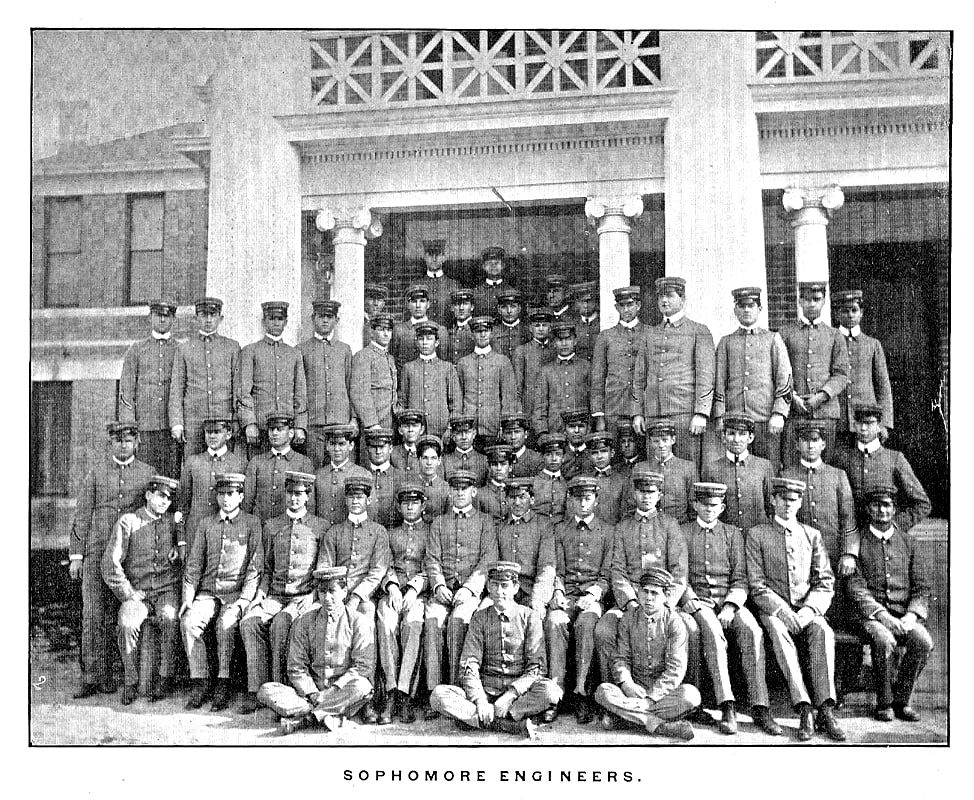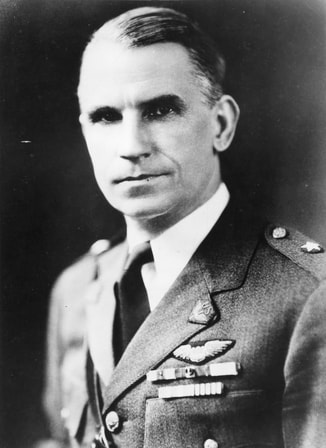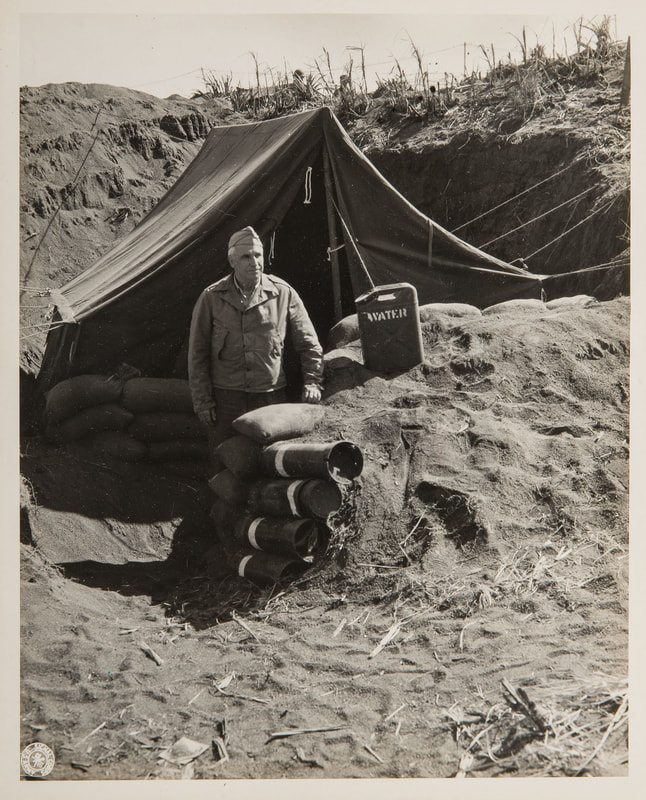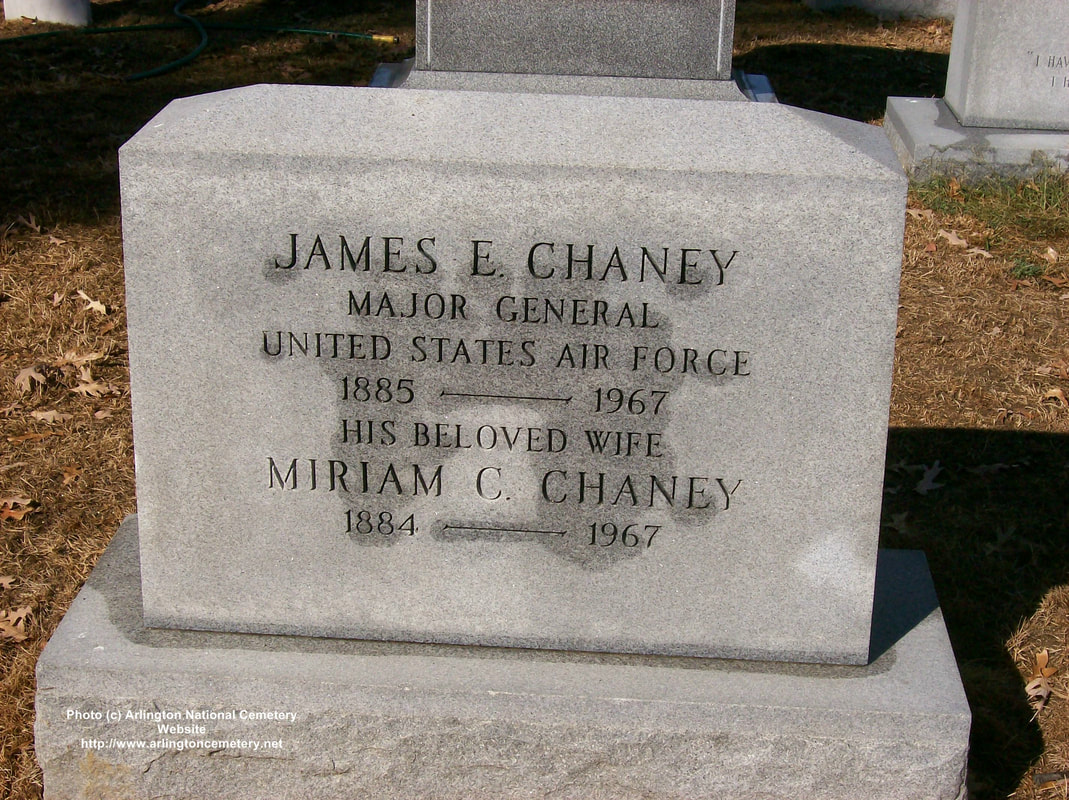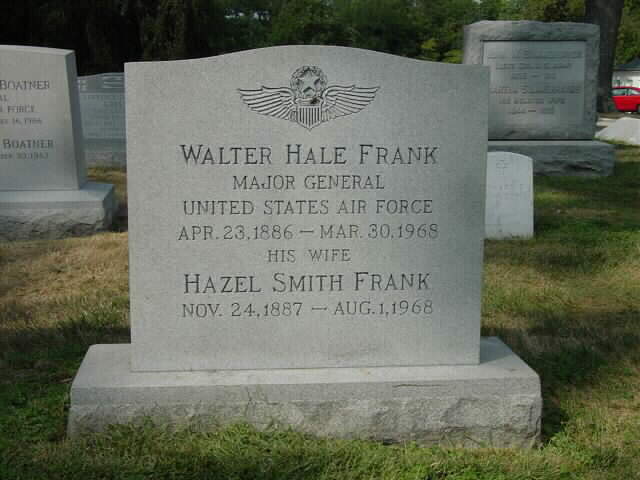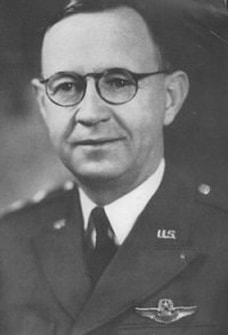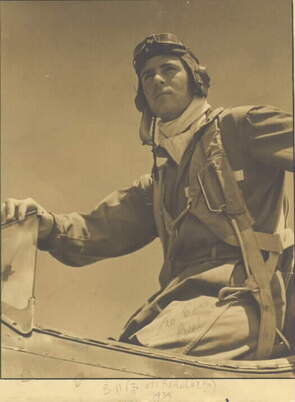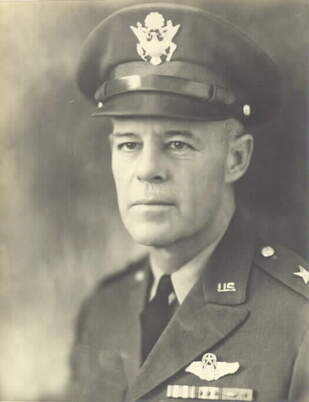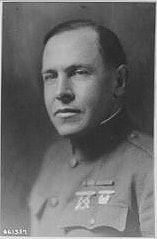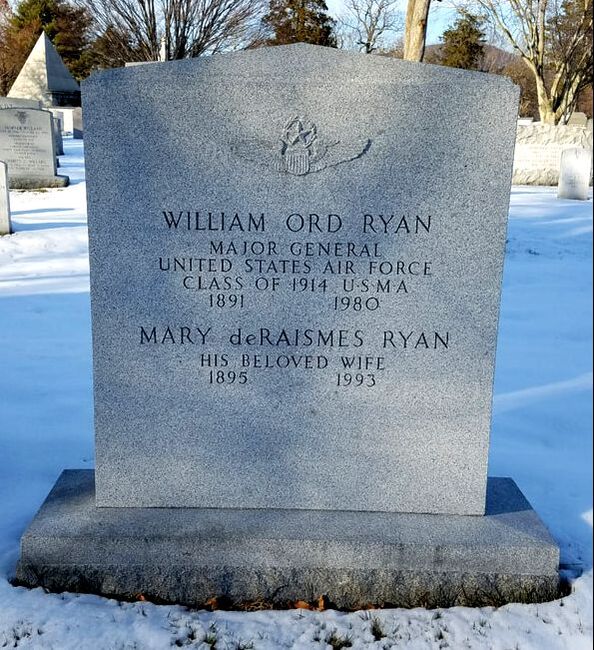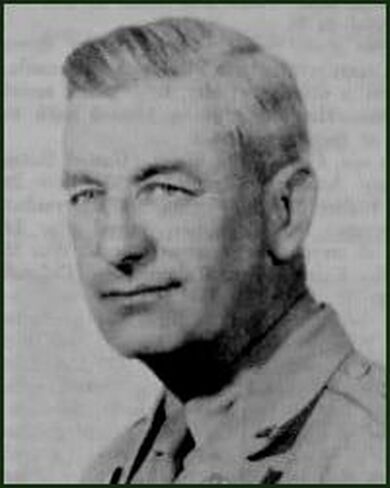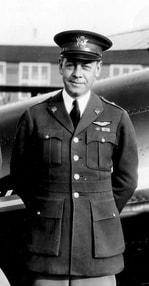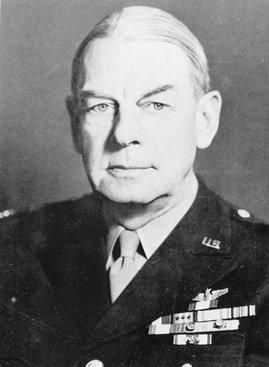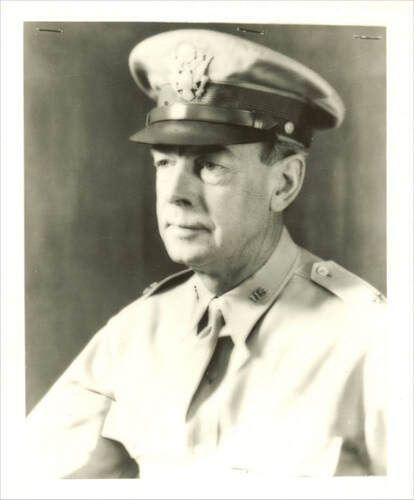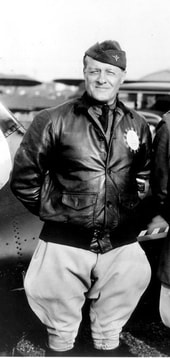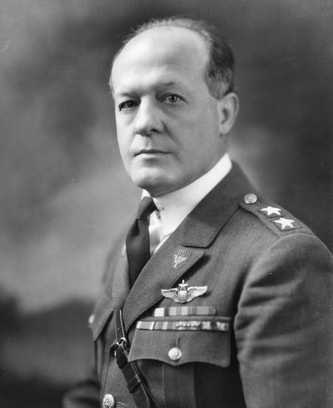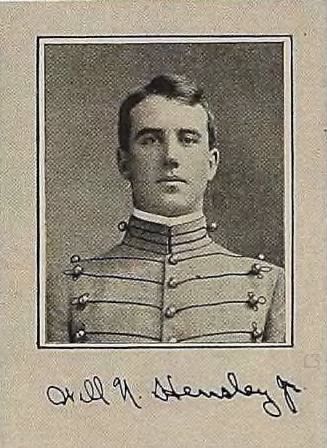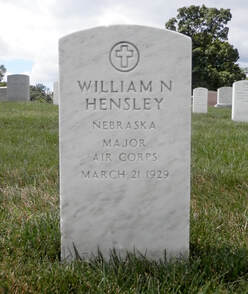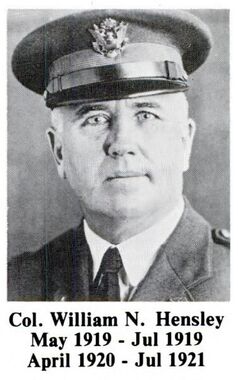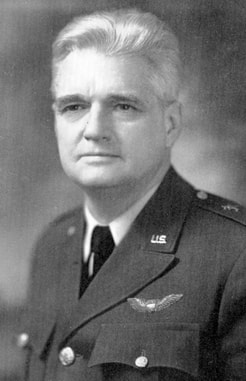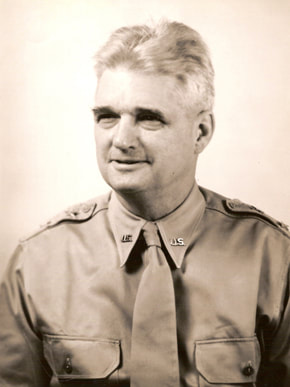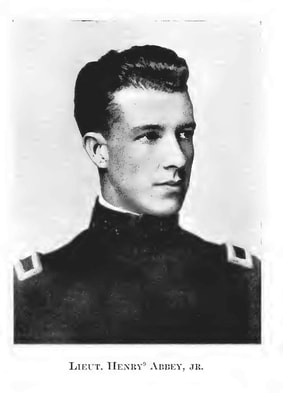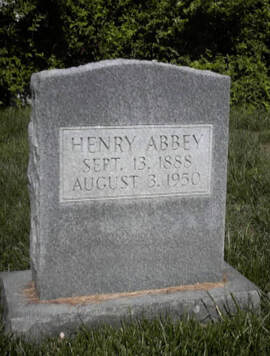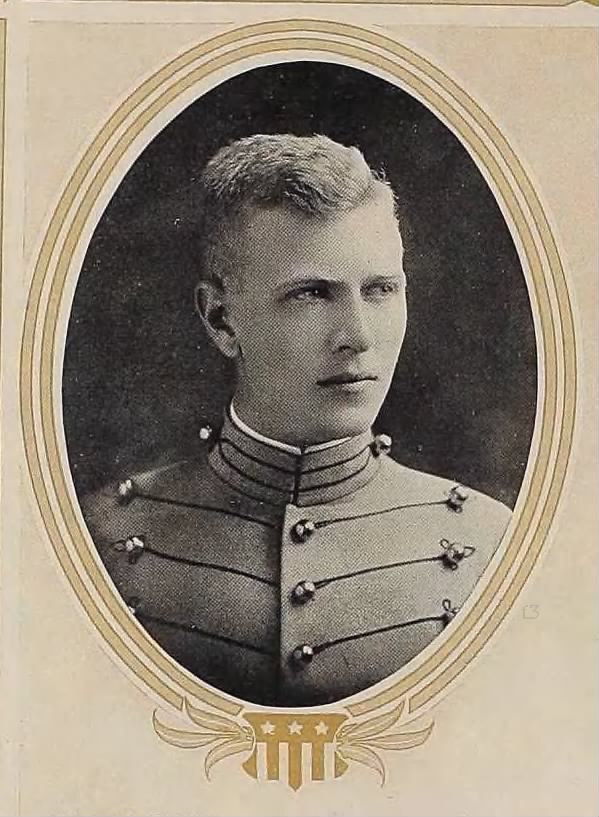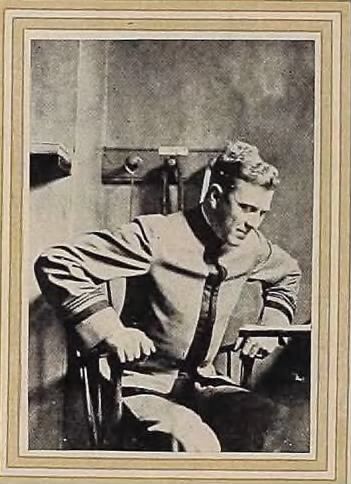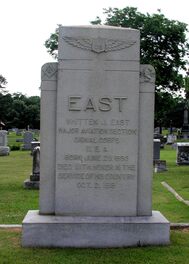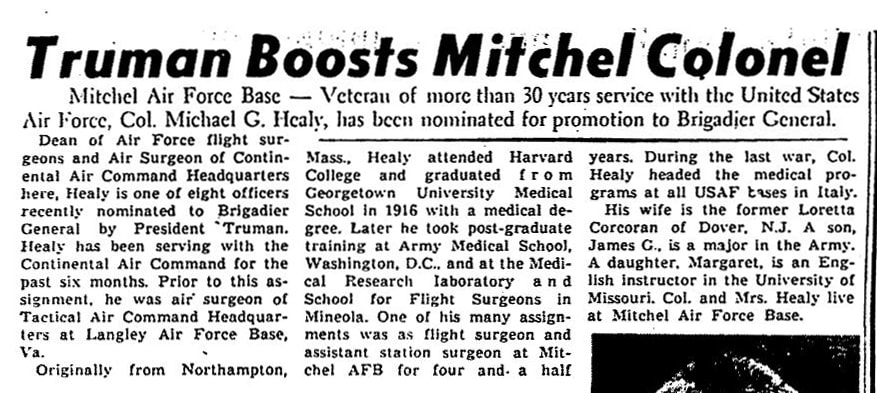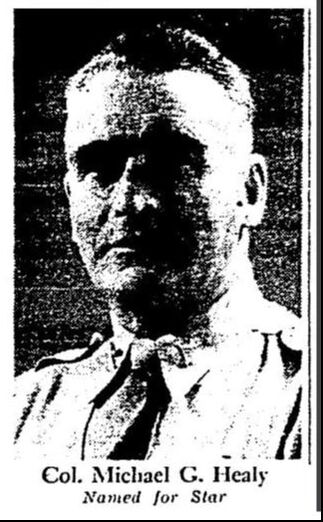- Home
- 5th Squadron Memorial
- Period Photos
- Walk Around 2020
- Postcards
- Modern Photos
- NCO Quarters Murals
- Aerial Views
- Santini
- Armed Forces Days
- Mitchel Field Band
- Artifacts, relics and memoribilia
- John Purroy Mitchel
- Mitchel/Selfridge
- Contact
- Links
- Videos
- NRHP Registration
- Crashes & Accidents Index
- AAF Convalescent Home
- Air Corps News Letter (ACNL)
- Commanding Officers
- HempsteadPlains.com
- Lancasters at Mitchel
- Newspapers and Magazines
- USO
- Roosevelt Field
- USO Jones Beach
- USO Mitchel Field
- USO Hempstead
- Military Camps
- Treason
- AA & Ground Forces
- Beneath the Shadow of Wings
Officer's Row on Rice Circle: 361, 362, 363, 364, 365 Rice Circle. 363 (Center house on the circle) was the Commanding Officers Home and high ranking officers lived in the others.
(From the NRHP Registration Form) 363, Senior Officers Housing, 1932 (1 contributing building) Two-story, side-gabled, five-bay by two-bay 1:5 brick house on a concrete foundation. One-story, Tuscan columned projecting brick entry porch with concrete steps. Two-story enclosed entry porch on north elevation. Six-over-six replacement windows. Wood cornice projects slightly at roofline, cornice returns on side gables. Slate roof. Building 363, originally the base commanding officer’s quarters (currently the college president’s house), has a one-story sunroom addition on the side opposite the two-story enclosed porch.
Built in 1932, the home has undergone extensive renovations. Although it looks the same from the outside, the layout of the inside has been revised numerous times through the years. The porch on the right was added in 1971. Long before we lived there, there was a glass greenhouse in the backyard! The white columns in front were replaced due to age and wood rot. The driveway was originally gravel. But every time they plowed the snow, half of the rocks would end up in the street. It was paved over in the '90's.
In 1968, it was converted from home heating oil to gas. In 1966 the main bathroom was remodeled. In 1967 the kitchen was too. In 1968 the basement was totally remodeled. There have been many other changes since that time. That house was the only one to have an addition to it in the back for servants quarters.
Since the base closed in 1961 the President of NCC has lived in that home with a mixture of VP's, Department Chairmen, Deans, etc. living in the others. President Chambers lived there from 1965-1979, along with his son Lee, who provided the above post-MF (NCC) historical info on the house. According to Lee, the four other homes on the circle have NOT undergone the numerous changes made to the "COs/Presidents" house. Thank you Lee for the wonderful info.
In 1968, it was converted from home heating oil to gas. In 1966 the main bathroom was remodeled. In 1967 the kitchen was too. In 1968 the basement was totally remodeled. There have been many other changes since that time. That house was the only one to have an addition to it in the back for servants quarters.
Since the base closed in 1961 the President of NCC has lived in that home with a mixture of VP's, Department Chairmen, Deans, etc. living in the others. President Chambers lived there from 1965-1979, along with his son Lee, who provided the above post-MF (NCC) historical info on the house. According to Lee, the four other homes on the circle have NOT undergone the numerous changes made to the "COs/Presidents" house. Thank you Lee for the wonderful info.
361, 362, 364, 365 Rice Circle. Executive officer's homes.
Commanding Officers
1918-1961
Most recent to earliest
Most recent to earliest
List may be incomplete as my research continues. Starting and ending dates approximate.
Col. Robert W. C. Wimsatt: (July) August 1949-May 1950
|
BRIGADIER GENERAL ROBERT WILLIAM CALVERT WIMSATT Retired July 31,1953 Died September 11, 1964 Robert William Calvert Wimsatt was born November 6, 1899, in Washington, D.C., where he was graduated from high school in 1917, and from Georgetown University with a Bachelor of Arts degree in philosophy, in 1921. He was commissioned a second lieutenant in the Air Service of the Regular Army November 1, 1921, and promoted immediately to first lieutenant. General Wimsatt then began flying training and was graduated from primary and advanced flying schools at Carlstrom Field, Florida, and Kelly Field, Texas, and rated a pilot in December, 1922. He was assigned as an instructor at the primary flying school at Brooks Field, Texas, until October, 1924, when he joined the 24th Pursuit Squadron in the Panama Canal Zone. In January, 1928, General Wimsatt was transferred to Langley Field, Virginia, where he served as a squadron operations officer and assistant post operations officer. In September, 1933, he was named adjutant and executive officer of the Middletown (Pennsylvania) Air Depot, and in December, 1936, became adjutant of the Headquarters School Squadron at the Air Corps Technical School, Chanute Field, Illinois. General Wimsatt entered the Air Corps Tactical School at Maxwell Field, Alabama, in September, 1937, and was graduated in June, 1938. He then entered the Command and General Staff School at Fort Leavenworth, Kansas, from which he was graduated in June, 1939, and assigned as operations officer at Bolling Field, D.C. I n June, 1942, General Wimsatt assumed command of the Greenland Base Command. In August, 1943, he became commander of the air base at Newport, Arkansas, and in June, 1944, was named commander of Bolling Field. General Wimsatt was appointed assistant chief of staff for operations of the U.S. Forces in China, in January, 1945. He assumed command of the 315th Service Group there in September, 1945. From December, 1945, to April, 1946, General Wimsatt had temporary duty with the Officers Selection Board at AAF headquarters, Washington, D.C. He then returned to China as acting commander of the Nanking Air Division and in June, 1946, became deputy commander. General Wimsatt returned to the United States in July, 1946, and two months later became commander of Langley Field. In August, 1947, he was appointed commanding officer of the 363rd Tactical Reconnaissance Wing at Langley Field, and in April, 1949, assumed command of the 4th Fighter Wing there. In July, 1949, he was transferred to Mitchel Air Force Base, New York, where he served as commander of the 52nd Fighter Wing until September, 1949; as base commander until May, 1950, and then as deputy for material of the First Air Force. In July, 1950, General Wimsatt was appointed commander of the 6208th Depot Wing in the Philippine Islands. In June, 1951, he assumed command of the 19th Bomb Wing on Guam. General Wimsatt has been awarded the Legion of Merit with one Oak Leaf Cluster, Bronze Star Medal, Army Commendation Ribbon, American Defense Service Medal, American Campaign Medal, Asiatic-Pacific Campaign Medal with one Bronze Star, European-African-Middle Eastern Campaign Medal, and World War II Victory Medal. He is rated a Command Pilot, Combat Observer, and Technical Observer. General Wimsatt and his wife, Mrs. Helen Huber Wimsatt, have four children. PROMOTIONS Second Lieutenant, Air Service, November 1, 1921; First Lieutenant, November 1, 1921; discharged as First Lieutenant, and appointed Second Lieutenant, December 15, 1922; First Lieutenant, December 28, 1926; Major (temporary), March 2, 1935, to June 16, 1936; Captain, August 1, 1935; Major (temporary), March 1, 1940; Major, July 1, 1940; Lieutenant Colonel (temporary), July 23, 1941; Lieutenant Colonel, A.U.S., December 24, 1941; Colonel, A.U.S. (Air Corps), March 1, 1942; Colonel, A.U.S., November 27, 1943; Lieutenant Colonel, November 1, 1944; Colonel, April 2, 1948; Brigadier General (temporary), March 8, 1952, with date of rank from January 26, 1952. Arlington National Cemetery
Arlington, Arlington County, Virginia, USA |
May 10, 1949
|
https://cdm16412.contentdm.oclc.org/digital/collection/p15349coll2/id/82
https://www.af.mil/About-Us/Biographies/Display/Article/2347345/brigadier-general-robert-william-calvert-wimsatt/
https://www.af.mil/About-Us/Biographies/Display/Article/2347345/brigadier-general-robert-william-calvert-wimsatt/
Col. Thomas C. Musgrave, Jr.: 1947-1949
|
MAJOR GENERAL THOMAS CEBERN MUSGRAVE JR.
Born July 5, 1913, Retired June 01, 1962 Died November 14, 2005 Thomas Cebern Musgrave Jr. was born in Washington, D.C., in 1913. He attended St. John's Military Academy in Delafield, Wis., entered the U.S. Military Academy, graduated June 12, 1935 and was commissioned a second lieutenant of Infantry. After graduating from Primary and Advanced Flying School at Randolph and Kelly fields, Texas on Oct. 1, 1936, General Musgrave transferred to the Air Corps. He was assigned to Langley Field, Va., with the 36th Pursuit Squadron until February 1939 when he moved to Wheeler Field, Hawaii with the Sixth Pursuit Squadron, 19th Pursuit Squadron and the 15th Pursuit Group successively. In March 1941 he became chief of the Special Project Sections at the Air Corps Advanced Flying School, Kelly Field, and that October he transferred to the Gulf Coast Air Corps Training Center Headquarters at Randolph Field. Moving to the Panama Canal Zone in November 1942, General Musgrave served with the Sixth Air Force, Sixth Bomber Command, 26th Fighter Command, and Sixth Air Force successively at Albrook Field. In December 1943 he was appointed assistant chief of staff for operations of the 58th Bomb Wing at Salina, Kan., and the following month assumed that position with the 73rd Bomb Wing there. He assumed command of the 499th Bomb Group at Clovis, N.M., in February 1944. Later that month he went to the Pacific Theater as commanding officer of the Fifth Bomb Group, 13th Air Force. Wounded in action over the Carolines on April 22, 1944, he was hospitalized until that Aug. 15, and then resumed command of the Fifth Bomb Group. Transferred to Army Air Force Headquarters at Washington, D.C. in April 1945, General Musgrave was named deputy chief of the Military Personnel Division in the Office of the Assistant Chief of Air Staff for Personnel. He was named executive officer that July, and a year later became executive officer to the commanding general of the Army Air Force. Entering the Air War College at Maxwell Field, Ala., in July 1947, he graduated a year later and assumed command of the 52nd Fighter Wing at Mitchel Air Force Base, N.Y. He entered the National War College in September 1949, graduated the following June, and a month later became deputy Air Force member of the Joint Strategic Plans Committee for Air Force Headquarters. Joining the Strategic Air Command in April 1952, General Musgrave assumed command of the 47th Air Division at Walker Air Force Base, N.M. Going to England in July 1954, he assumed command of the Seventh Air Division, SAC. Returning to Washington D.C., Aug. 20, 1955, General Musgrave became Deputy U.S. Representative to the Standing Group, North Atlantic Treaty Organization until Jan. 9, 1956 when he was assigned as deputy director, Manpower and Organization, in the Office of the Deputy Chief of Staff, Operations, Headquarters U.S. Air Force, becoming the director on June 14, 1956. His decorations include the Legion of Merit, Bronze Star Medal Distinguished Flying Cross, Air Medal with two oak leaf clusters, Peruvian Military Order of Ayachucho and the Bolivian Order of Condor of the Andes. He is rated a command pilot. |
Fort Sam Houston National Cemetery
San Antonio, Bexar County, Texas, USA courtesy Findagrave.com |
https://www.af.mil/About-Us/Biographies/Display/Article/106107/major-general-thomas-cebern-musgrave-jr/
https://www.legacy.com/obituaries/sanantonio/obituary.aspx?n=thomas-c-musgrave&pid=88860474
Col. E. E. Hildreth: (Edward Ernest) January 5, 1945- January 25, 1946
Jan. 5, 1945: Col. E.E. Hildreth became commanding officer of this base today succeeding Col. Francis H. Mathews, who became executive officer.
Col. Francis H. Matthews: October 20, 1944- January 5, 1945
Col. Douglas Johnston: August 14, 1941-October 20, 1944
Col. Thomas J. Hanley: June 24, 1941-August 14, 1941
Col. Thomas J. Hanley: February 7, 1938- September 2, 1938
|
MAJOR GENERAL THOMAS JAMES HANLEY JR.
Died March 01, 1969 Thomas James Hanley Jr., was born at Coshocton, Ohio, in 1893, the third of six children of Thomas J. Hanley Sr., who had come to the United States from Ireland, and the former Miss Mary Margaret O'Connor at Cresson, Pa. He graduated from the U.S. Military Academy and was commissioned a second lieutenant of Infantry June 12, 1915. His first assignment was with the 23rd Infantry at Texas City, Texas. In August 1916, he was detailed to the Aviation Section of the Signal Corps and entered the Signal Corps Aviation School at San Diego, Calif. After graduating from flying school the following April, he was assigned to the First Aero Squadron at Columbus, N.M., and a month later transferred to Kelly Field, Texas, where he served successively with the 5th and 19th aero squadrons. |
In July 1917, he transferred to Chanute Field, Ill., as assistant officer in charge of flying at that station. He was designated assistant officer in charge of flying at Rich Field, Texas, in January 1918, and the following month became commanding officer of the 274th Aero Squadron at Taliaferro Field, Texas. In March 1918, he was appointed engineering officer and commanding officer of Taliaferro Field.
Two months later he was appointed commanding officer of Carruthers Field, Texas. From January to February 1919, he took an advanced course in pursuit flying at Rockwell Field, Calif., and then returned to Carruthers Field, where he served until December 1919.
He then transferred to Langley Field, Va., for service as executive officer and in June 1920 was appointed commanding officer of the First Army Observation Group.
On July 1, 1920, he was transferred from the Infantry to the Air Service.
The following month he went to Post Field, Fort Sill, Okla., to organize a detachment of the 135th Squadron and later went to Fort Leavenworth, Kan., in command of this unit. In November 1920, he returned to Langley Field for duty as director of the administration course and as a student at the Field Officer's School, later redesignated the Tactical School. In May 1921, he assumed command of the Second Provisional Bombing Group and the 14th Squadron.
He commanded the First Provisional Bombardment Wing briefly in September 1921, and then returned to his duties as instructor at the Tactical School.
In December 1921, he was transferred to the Philippine Islands and assigned to Kindley Field at Fort Mills, where he commanded the second Observation Squadron from March to August 1922 and the Provisional Administration Company until September 1922. He then went to Camp Nichols, Philippine Islands, to assume command of the 28th Bombardment Squadron.
Returning to the United States in March 1924, he assumed command of Crissy Field, Calif., and the 91st Observation Squadron at that station. He entered the Army Industrial College at Washington in August 1924, and after graduating the following February was assigned to the Office of the Assistant Secretary of War at Washington.
In August 1928, he entered the Command and General Staff School at Fort Leavenworth, Kan., and upon graduation two years later became assistant commandant of the Advanced Flying School at Kelly Field, Texas. In October 1931, he transferred to the Primary Flying School at Randolph Field, Texas, for duty as executive officer and assistant commandant. In June 1932, he became an instructor at the Command and General Staff School and four years later was appointed executive officer of Mitchel Field, N.Y.
In June 1939, he was named assistant chief of staff for operations of the Puerto Rican Department. He returned to the United States in June 1941, to assume command of Mitchel Field, N.Y. Shortly afterward he was named chief of the First Air Force and in November 1941, became First Air Force base commander. The following January he was assigned to AAF headquarters in Washington and appointed assistant chief of air staff for materiel. He later became deputy chief of staff of the AAF and in May 1943, assumed command of the Southeast Air Force Training Center at Maxwell Field, Ala. In April 1944, he went to Patterson Field, Ohio, for a brief tour of duty with the Air Service Command.
The following month he went overseas as commanding general of the China-Burma-India Air Service Command, with station in India. In July 1945, he assumed command of the Army Air Forces in India and Burma, in addition to his duties of the Air Service Command. Returning to the United States in January 1946, he was assigned to AAF headquarters in Washington and in May of that year went to Air Defense Command headquarters at Mitchel Field, N.Y. He assumed command of the 11th Air Force at Harrisburg, Penn., June 14, 1946. He was appointed chief of the Military Personnel Procurement Service Division in the Office of the Adjutant General at Washington, D.C., in March 1948.
General Hanley has been awarded the Distinguished Service Medal, Legion of Merit with oak leaf cluster, Air Medal and American Defense Medal, and is an honorary member of the Yugoslav and Chinese air forces. He is rated a command pilot, combat observer and tactical observer.
Two months later he was appointed commanding officer of Carruthers Field, Texas. From January to February 1919, he took an advanced course in pursuit flying at Rockwell Field, Calif., and then returned to Carruthers Field, where he served until December 1919.
He then transferred to Langley Field, Va., for service as executive officer and in June 1920 was appointed commanding officer of the First Army Observation Group.
On July 1, 1920, he was transferred from the Infantry to the Air Service.
The following month he went to Post Field, Fort Sill, Okla., to organize a detachment of the 135th Squadron and later went to Fort Leavenworth, Kan., in command of this unit. In November 1920, he returned to Langley Field for duty as director of the administration course and as a student at the Field Officer's School, later redesignated the Tactical School. In May 1921, he assumed command of the Second Provisional Bombing Group and the 14th Squadron.
He commanded the First Provisional Bombardment Wing briefly in September 1921, and then returned to his duties as instructor at the Tactical School.
In December 1921, he was transferred to the Philippine Islands and assigned to Kindley Field at Fort Mills, where he commanded the second Observation Squadron from March to August 1922 and the Provisional Administration Company until September 1922. He then went to Camp Nichols, Philippine Islands, to assume command of the 28th Bombardment Squadron.
Returning to the United States in March 1924, he assumed command of Crissy Field, Calif., and the 91st Observation Squadron at that station. He entered the Army Industrial College at Washington in August 1924, and after graduating the following February was assigned to the Office of the Assistant Secretary of War at Washington.
In August 1928, he entered the Command and General Staff School at Fort Leavenworth, Kan., and upon graduation two years later became assistant commandant of the Advanced Flying School at Kelly Field, Texas. In October 1931, he transferred to the Primary Flying School at Randolph Field, Texas, for duty as executive officer and assistant commandant. In June 1932, he became an instructor at the Command and General Staff School and four years later was appointed executive officer of Mitchel Field, N.Y.
In June 1939, he was named assistant chief of staff for operations of the Puerto Rican Department. He returned to the United States in June 1941, to assume command of Mitchel Field, N.Y. Shortly afterward he was named chief of the First Air Force and in November 1941, became First Air Force base commander. The following January he was assigned to AAF headquarters in Washington and appointed assistant chief of air staff for materiel. He later became deputy chief of staff of the AAF and in May 1943, assumed command of the Southeast Air Force Training Center at Maxwell Field, Ala. In April 1944, he went to Patterson Field, Ohio, for a brief tour of duty with the Air Service Command.
The following month he went overseas as commanding general of the China-Burma-India Air Service Command, with station in India. In July 1945, he assumed command of the Army Air Forces in India and Burma, in addition to his duties of the Air Service Command. Returning to the United States in January 1946, he was assigned to AAF headquarters in Washington and in May of that year went to Air Defense Command headquarters at Mitchel Field, N.Y. He assumed command of the 11th Air Force at Harrisburg, Penn., June 14, 1946. He was appointed chief of the Military Personnel Procurement Service Division in the Office of the Adjutant General at Washington, D.C., in March 1948.
General Hanley has been awarded the Distinguished Service Medal, Legion of Merit with oak leaf cluster, Air Medal and American Defense Medal, and is an honorary member of the Yugoslav and Chinese air forces. He is rated a command pilot, combat observer and tactical observer.
Col. Douglas Blakeshaw Netherwood: March 15, 1940-June 23, 1941
|
Douglas Blakeshaw was born on February 4, 1885 in Birmingham, United Kingdom. Son of Tom and Ann (Wood) Netherwood. Died August 19, 1943
Brought to the United States, 1887, naturalized U.S. citizen, 1910. Bachelor of Science in Mechanical Engineering, Agricultural & Mechanical College of Texas, 1908. Master of Business Administration, Harvard Graduate School of Business Administration, 1927. Graduated: Army Industrial College, 1925; Air Corps Tactical School, 1932; Army Industrial College, 1934; Army War College, 1936. Career: Enlisted in U.S. Army, 1908, Fort Sam Houston, TX. Served in 20th Company Coast Artillery Corps (C.A.C.) at Ft. Barrameas, FL as private, corporal, sergeant till 1911. Commissioned 2nd Lt. C.A.C. second in command in 1911. Commanded 160th Company "Battery Russell" seacoast battery 1912-1913. Applied for and joined U.S. Army 1st Aero Squadron and completed Signal Corps Aviation School, North Island, CA, 1913, with first solo flight, San Diego, CA, Feb. 7, 1914. 1914-1939 advanced through Aero Club of America aviator certification ratings of Junior Military Aviator, Expert Aviator, Military Aviator, Airplane Pilot, Airplane Observer, Command Pilot, and Combat Observer. 1914-1940 advanced through military grades to brigadier general (temporary) with commands at: Aviation Repair Depot, Love Field, Dallas; Souths Field, Americus, GA; Nichols Field and Group Commander 4th Composite Group, Manila, Philippine Islands; Air Corps Board, Maxwell Field, Montgomery, AL; Mitchel Field and NY World's Fair Aviation Building, Long Island, NY; 13th Bombardment Wing, Albrook Field, 13 Strategic Missile Division, Panama Canal Zone; Borinquen Field, Puerto Rico; Baer Field, Fort Wayne, IN. Membership Army and Navy Club , Manila
Douglas Blakeshaw Netherwood was in an aircraft (I believe an Army high-wing, single-engine, 2-seater, Piper-like utility aircraft) somewhat like the attachment that was being flown by an NCO who had taken off with my grandfather from an airfield in Florida and never returned. In the early 1960s, a nearly intact fuselage of this aircraft was found in the Okeefenokee Swamp of Florida by an airboat hunting or fishing party. The only artifact found in the cockpit was a flight boot believed to be the pilot's. There was no evidence of it having been a fatal crash, but anything else would be speculation Via email from Blake Netherwood, 12-4-05 Grandson of D. B. Netherwood, Courtesy Ralph Cooper, https://www.earlyaviators.com/enetherw.htm Married to Harriet Van Cortlandt Bowne on April 30, 1919. Children: Douglas Blakeshaw, Jr., Francis Bowne, William Draper, Elizabeth Grant. |
College Station, TX
1906 Texas A&M Sophomore Engineers, Cadet D. B. Netherwood Third from Left Sitting |
SOURCES: https://prabook.com/web/douglas.netherwood/1093618
https://generals.dk/general/Netherwood/Douglas_Blackshaw/USA.html
Col. James E. Chaney: September 3, 1938- March 14, 1940
|
MAJOR GENERAL JAMES E. CHANEY
James Eugene Chaney was born at Chaney, Md., in 1885, the son of Dr. Thomas W. Chaney. He attended Baltimore City College for three years and was appointed to the U.S. Military Academy, West Point, N.Y., June 16, 1904. Upon graduation Feb. 14, 1908, he was appointed a second lieutenant of Infantry. SERVICE He first served with the 9th Infantry at Fort Sam Houston, Texas to February 1910; then detached service in Europe, Africa and Asia to July 1910. He next served with his regiment at Iloilo, Philippine Islands, to June 1912. he returned to the U.S. to became instructor in modern languages at the U.S. Military Academy, West Point, N.Y. until July 1914. In September 1914, he joined the 30th Infantry at the Presidio of San Francisco, Calif. He served with the 25th Infantry at Schofield Barracks, Hawaii to September 1917, when he was detailed in the Air Service and returned to the U.S. He was stationed at Chanute Field, Ill., until November 1917; became commandant of the School of Military Aeronautics, Columbus, Ohio to June 1918; and executive officer, Operations Section, Office of the Director of Military Aeronautics, Washington, D.C. to August 1918. He sailed for Europe in August 1918, where he served at Air Service Headquarters Service of Supplies, to September 1918; with the Coordination Staff, Headquarters of the Chief of Air Service, American Expeditionary Forces, to October 1918; and in the Office of the Chief of Air Service and executive officer, Office of the Assistant Chief of Staff, Air Service, American Expeditionary Forces to February 1919. He commanded the airdrome at Cablenz, Germany to April 1919 and served in the Office of the Air Service Commander, Third Army, at Coblenz, Germany to June 1919. He then commanded the Air Service Production Center at Romerantin, France to August 1919 and was U.S. aviation officer, Provisional District of Great Britain to October 1919. He was appointed assistant military attach for aviation at Rome, Italy in October 1919, where he served until June 1924. In the summer of 1924 he was assigned to duty at Langley Field, Va., to October 1924. He attended the Command and General Staff School at Fort Leavenworth, Kan., completing the course as an honor graduate in June 1926. He was commandant of the Air Corps Primary Flying School, Brooks Field, to March 1928, and commandant of the Air Corps Advanced Flying School, Kelly Field, Texas, to June 1930. |
He then attended the Army War College in Washington, D.C. to June 1931, and after graduation was assigned to duty in the Office of the Chief of Air Corps in Washington, D.C., until January 1932. He next served as technical adviser on aviation matters to General George S. Simonds at the Disarmament Conference at Geneva, Switzerland to June 1932. When he returned to the U.S., he resumed his duties in the Office of the Chief of the Air Corps, Washington, D.C., where he served until April 1935, during which period he was made assistant chief of the Air Corps.
In May 1935, he took command of the Air Corps Training Center at Randolph Field, Texas, in which capacity he served until completion of his tour as assistant chief of Air Corps in July 1938. He was then ordered to Mitchel Field, N.Y., where in January 1940, he was made head of the Air Defense Command. In October 1940, he was assigned additionally as commanding general of the Northeast Air District, with Headquarters at Mitchel Field, N.Y., later called the First Air Force. In October-November 1940, he was in England as observer during part of the Battle of Britain and the bombing of London. In May 1941, he was assigned to the United Kingdom, with station at London, England, as special Army observer and head of the Special Army Observers Group there. From January 1942 to June 1942, he was the commanding general, U.S. Army Forces in the British Isles.
He was assigned, in July 1942 as commanding general of the First Air Force, with Headquarters at Mitchel Field, N.Y. From May 1942 to November 1944, he commanded the Army Air Forces Basic Training Center at Sheppard Field, Texas, and then the Air Forces Western Technical Training Command with Headquarters in Denver, Colo. From November 1944 to July 1945, he commanded Army forces in the preparation, the seizure, occupation and development of Iwo Jima. From March of 1945, as island commander, he commanded all U.S. forces on Iwo Jima (Army, Navy, Air Forces and Marines). In August of 1945, he was named as commanding general of the Western Pacific Base Command, with Headquarters on Saipan. In October 1945, he was assigned as member and later as president, Secretary of War's Personnel Board, Washington, D.C.
Iwo Jima in the Western Pacific, about 700 miles south of Tokyo, spearheaded the American drive on Japan proper. It formed a base for bomber and fighter operations against Japan proper, and a refuge for many battle-damaged B-29's operating against Japan from the Marianas.
He is rated a military command pilot, combat observer, and technical observer.
In May 1935, he took command of the Air Corps Training Center at Randolph Field, Texas, in which capacity he served until completion of his tour as assistant chief of Air Corps in July 1938. He was then ordered to Mitchel Field, N.Y., where in January 1940, he was made head of the Air Defense Command. In October 1940, he was assigned additionally as commanding general of the Northeast Air District, with Headquarters at Mitchel Field, N.Y., later called the First Air Force. In October-November 1940, he was in England as observer during part of the Battle of Britain and the bombing of London. In May 1941, he was assigned to the United Kingdom, with station at London, England, as special Army observer and head of the Special Army Observers Group there. From January 1942 to June 1942, he was the commanding general, U.S. Army Forces in the British Isles.
He was assigned, in July 1942 as commanding general of the First Air Force, with Headquarters at Mitchel Field, N.Y. From May 1942 to November 1944, he commanded the Army Air Forces Basic Training Center at Sheppard Field, Texas, and then the Air Forces Western Technical Training Command with Headquarters in Denver, Colo. From November 1944 to July 1945, he commanded Army forces in the preparation, the seizure, occupation and development of Iwo Jima. From March of 1945, as island commander, he commanded all U.S. forces on Iwo Jima (Army, Navy, Air Forces and Marines). In August of 1945, he was named as commanding general of the Western Pacific Base Command, with Headquarters on Saipan. In October 1945, he was assigned as member and later as president, Secretary of War's Personnel Board, Washington, D.C.
Iwo Jima in the Western Pacific, about 700 miles south of Tokyo, spearheaded the American drive on Japan proper. It formed a base for bomber and fighter operations against Japan proper, and a refuge for many battle-damaged B-29's operating against Japan from the Marianas.
He is rated a military command pilot, combat observer, and technical observer.
Col. Thomas J. Hanley: February 7, 1938- September 2, 1938
Col. Walter H. Frank: August 24, 1934-February 6, 1938
MAJOR GENERAL WALTER H. FRANK
Walter Hale Frank was born on April 23, 1886, in Humphrey, N.Y. He was appointed to the Military Academy and received a Bachelor of Science degree in 1910. He was appointed a second lieutenant of Infantry on June 15, 1910, and first served with the 5th Infantry at Plattsburg Barracks, N.Y., until November 1914. He then served as Commanding Officer, 25th Infantry, Schofield Barracks, Hawaii, from August 1914 to July 1917, and was later on duty as Company and Battalion Commander, 34th Infantry, Fort Bliss, Texas, from August 1917 to October 1917.
After completion of Arms School at Fort Sill, Okla., he commanded the Provisional Regiment at Kelly Field, Texas, and later served as Executive Officer at Ellington Field, Texas, from November 1917 to November 1918. For the next year he was Executive Officer, Training Section, Air Service; Assistant to the Administrative Executive, Air Service; and a member of the Advisory Board, Air Service, Washington, D.C. He was then assigned as Assistant to the Commanding Officer and later as a student at the Air Service Engineering School at McCook Field, Ohio, from November 1919 to September 1920.
From September 1920 to September 1924 he was Acting Executive and Executive, Office of the Chief of Air Staff, Washington, D.C. He completed Air Service Tactical School at Langley Field, Va., and Command and General Staff School at Fort Leavenworth, Kan. He was next assigned as Assistant Commandant and Instructor, Air Tactical School, Langley Field, Va., from September 1926 to July 1930 before entering the Army War College, graduating in June 1931.
He served as Chief, Section III, and as Assistant to the Chief, Plans Division, Office of the Chief of Air Corps, Washington, D.C., from July 1931 to August 1934; Commanding Officer of Mitchel Field, N.Y.; Group Commander, 9th Bombardment Group; and Commanding Officer, 2nd Air Base, Mitchel Field, N.Y., from August 1934 to February 1938. From February 1938 to August 1938, he was Chief of Staff, General Headquarters Air Force, Langley Field, Va.
He commanded the 18th Wing, Air Corps, and Department Air Officer, Headquarters Hawaiian Department, Fort Shafter, from September 1938 to November 1940, and Commanding General, New Orleans Army Air Base, La., from January 1941 to March 1941. He was on duty with the Third Interceptor Command and Third Air Force, Air Force Combat Command, Bolling Field, D.C., from October 1941 to June 1942.
From July 1942 to November 1942 he was Commanding General, VIII Air Force Service Command in the European Theater of Operations, and from November 1942 to June 1944, he was Commanding General, Air Service Command, Patterson Field, Ohio. He was assigned to Headquarters Army Air Forces, Washington, D.C., with station at Dayton, Ohio, from July 1944 to September 1945.
He is a command pilot, combat observer and technical observer. His awards include the Distinguished Service Medal, Legion of Merit and Air Medal.
PROMOTIONS
Sept. 30, 1938; Colonel (permanent), June 12, 1939; Brigadier General (permanent), Oct. 1, 1940; Major General, Oct. 31, 1941.
Walter Hale Frank was born on April 23, 1886, in Humphrey, N.Y. He was appointed to the Military Academy and received a Bachelor of Science degree in 1910. He was appointed a second lieutenant of Infantry on June 15, 1910, and first served with the 5th Infantry at Plattsburg Barracks, N.Y., until November 1914. He then served as Commanding Officer, 25th Infantry, Schofield Barracks, Hawaii, from August 1914 to July 1917, and was later on duty as Company and Battalion Commander, 34th Infantry, Fort Bliss, Texas, from August 1917 to October 1917.
After completion of Arms School at Fort Sill, Okla., he commanded the Provisional Regiment at Kelly Field, Texas, and later served as Executive Officer at Ellington Field, Texas, from November 1917 to November 1918. For the next year he was Executive Officer, Training Section, Air Service; Assistant to the Administrative Executive, Air Service; and a member of the Advisory Board, Air Service, Washington, D.C. He was then assigned as Assistant to the Commanding Officer and later as a student at the Air Service Engineering School at McCook Field, Ohio, from November 1919 to September 1920.
From September 1920 to September 1924 he was Acting Executive and Executive, Office of the Chief of Air Staff, Washington, D.C. He completed Air Service Tactical School at Langley Field, Va., and Command and General Staff School at Fort Leavenworth, Kan. He was next assigned as Assistant Commandant and Instructor, Air Tactical School, Langley Field, Va., from September 1926 to July 1930 before entering the Army War College, graduating in June 1931.
He served as Chief, Section III, and as Assistant to the Chief, Plans Division, Office of the Chief of Air Corps, Washington, D.C., from July 1931 to August 1934; Commanding Officer of Mitchel Field, N.Y.; Group Commander, 9th Bombardment Group; and Commanding Officer, 2nd Air Base, Mitchel Field, N.Y., from August 1934 to February 1938. From February 1938 to August 1938, he was Chief of Staff, General Headquarters Air Force, Langley Field, Va.
He commanded the 18th Wing, Air Corps, and Department Air Officer, Headquarters Hawaiian Department, Fort Shafter, from September 1938 to November 1940, and Commanding General, New Orleans Army Air Base, La., from January 1941 to March 1941. He was on duty with the Third Interceptor Command and Third Air Force, Air Force Combat Command, Bolling Field, D.C., from October 1941 to June 1942.
From July 1942 to November 1942 he was Commanding General, VIII Air Force Service Command in the European Theater of Operations, and from November 1942 to June 1944, he was Commanding General, Air Service Command, Patterson Field, Ohio. He was assigned to Headquarters Army Air Forces, Washington, D.C., with station at Dayton, Ohio, from July 1944 to September 1945.
He is a command pilot, combat observer and technical observer. His awards include the Distinguished Service Medal, Legion of Merit and Air Medal.
PROMOTIONS
Sept. 30, 1938; Colonel (permanent), June 12, 1939; Brigadier General (permanent), Oct. 1, 1940; Major General, Oct. 31, 1941.
Major Follett Bradley: (Temporary) June 1, 1933-June 8, 1933
December 16, 1933- January 14, 1934
May 29, 1934-August 23, 1934
|
MAJOR GENERAL FOLLETT BRADLEY
Retired May 01,1944 Died August 04,1952 Follett Bradley was born in Omaha, Neb., in 1890. He attended the U.S. Naval Academy and graduated with a bachelor of science degree on June 4, 1910, and was commissioned an Ensign. He served in the Navy until Jan. 24, 1912, when he accepted a commission as second lieutenant of Field Artillery, U.S. Army. His first assignment was with the 6th Field Artillery at Fort Riley, Kan. A pioneer in aviation, as far back as 1912, he participated on several flights in an early Wright biplane at Fort Riley developing aerial spotting techniques for field artillery fire coordination. In June 1914, he accompanied his regiment to Laredo, Texas, was promoted to first lieutenant and detailed to the Ordnance Department. The following year he was ordered to the Sandy Hook Proving Ground, N.J., to attend the Ordnance School of Application. In 1916 he learned to fly at Mineola, Long Island, N.Y. He was promoted to captain on May 15, 1917, and in August 1917 was ordered overseas, serving under the Air Commander, American Expeditionary Forces, Zone of Advance, connected with the armament of airplanes and aerial gunnery. During his service overseas, he piloted Curtiss, Nieuport, Spad and DeHaviland type airplanes. On Nov. 26, 1917, he received the rating of Junior Military Aviator. |
On Jan. 10, 1918, he was relieved from duty with the Air Service and was assigned to the 17th Field Artillery. He was promoted to major on July 2, 1918. He took part in the Aisne Defensive, in the capture of Vaux in July 1918, and in the Aisne-Marne Offensive from July 18 to July 26, 1918. He was cited for gallantry and received the Silver Star and the French Croix de Guerre with palms. He was promoted to temporary lieutenant colonel on July 30. In September he returned to the United States and placed on duty as Instructor at the Artillery School of Fire at Fort Sill, Okla. In the meantime, he availed himself of every opportunity to keep in flying practice. He passed the examination for the rating of Airplane Pilot on Aug. 12, 1920.
In August 1921, he was assigned as a student at the Air Service Engineering School at McCook Field, Dayton, Ohio. After graduation in August 1922, he was transferred to Chanute Field, Rantoul, Ill., as the Assistant Commandant of the Air Service Technical School. In August 1923, he was transferred to the Panama Canal Department and served in the dual capacity of Commanding Officer of France Field and the 6th Composite Group and as Air Officer of the Panama Canal Department. In September 1926, he was assigned as a student at the Air Corps Tactical School at Langley Field, Va. Graduating the following year, he attended the Command and General Staff School at Fort Leavenworth, Kansas. He then returned to Langley Field for duty as Instructor at the Tactical School, and also held the position of Director of Instruction.
From August 1931 to June 1933, he completed one year courses at the Army War College, Washington, D.C., and the Naval War College, Newport, R.I. In June 1933, he was assigned to duty at Mitchel Field, N.Y., as Commanding Officer of the 9th Observation Group. When the Army Air Corps took over the operations of the Air Mail from February to June 1934, he served in the capacity of Chief Inspector. In June 1934, he was detailed as a member of the War Department General Staff and assigned to the War Plans Division, remaining in this duty until March 1, 1935, when he was promoted to lieutenant colonel and assigned to duty at General Headquarters Air Force, Langley Field, Va., as Assistant Chief of Staff, G3, for Military Intelligence. He was promoted to colonel on Aug. 26, 1936.
In January 1938, he was ordered to Moffett Field, Calif., where he served as Commanding Officer until June 1939. He was then transferred to Puerto Rico as Department Air Officer. On Oct. 1, 1940, he was promoted to brigadier general and assigned to command the 13th Composite Wing in Puerto Rico on Nov. 20, 1940. On July 19, 1941, he commanded the 3rd Bombardment Wing at MacDill Field, Fla. On Sept. 29, 1941, he was placed in charge of the 3rd Bomber Command at Drew Field, Fla., and in March 1942 he was promoted to major general and assigned as Commanding General of the First Air Force at Mitchel Field, N.Y. On July 21, 1942, he was transferred to the Army Group, Washington, D.C. On March 15, 1943, he was assigned to the Air Inspector, Army Air Forces, Washington, D.C. In recognition of his distinguished service from June 1942 to June 1943, he was awarded the Distinguished Service Medal.
General Bradley was awarded the Distinguished Service Medal, French Croix de Guerre with Bronze Star; World War I Victory Medal with three Battle Clasps for the Aisne, Aisne Marne and Defense Sector Campaigns; Mexican Border Service Medal, Distinguished Flying Cross; Army Commendation Ribbon; American Defense Service Medal with Foreign Service Clasp; European-African Middle Eastern Campaign Medal; World War II Victory Medal; Aviation Badge 'Command Pilot'.
MAJOR GENERAL BRADLEY, LONG AN AIRMAN, 62 Ex-Leader of Eastern Theater at Mitchel Field is Dead
Sped ’42 Aid to Russia
NEW YORK, New York, August 5, 1952 – Major General Follett Bradley, UISAF, retired, died yesterday of a heart attack at Nassau Hospital, Mineola, Long Island, where he had been a patient for two days. He was 62 years old. His home was at 66 Poplar Street, Garden City, Long Island. He retired in April 1944 and died on 4 August 1952, Mineola, New York. He was buried in with full military honors in Arlington National Cemetery.
In August 1921, he was assigned as a student at the Air Service Engineering School at McCook Field, Dayton, Ohio. After graduation in August 1922, he was transferred to Chanute Field, Rantoul, Ill., as the Assistant Commandant of the Air Service Technical School. In August 1923, he was transferred to the Panama Canal Department and served in the dual capacity of Commanding Officer of France Field and the 6th Composite Group and as Air Officer of the Panama Canal Department. In September 1926, he was assigned as a student at the Air Corps Tactical School at Langley Field, Va. Graduating the following year, he attended the Command and General Staff School at Fort Leavenworth, Kansas. He then returned to Langley Field for duty as Instructor at the Tactical School, and also held the position of Director of Instruction.
From August 1931 to June 1933, he completed one year courses at the Army War College, Washington, D.C., and the Naval War College, Newport, R.I. In June 1933, he was assigned to duty at Mitchel Field, N.Y., as Commanding Officer of the 9th Observation Group. When the Army Air Corps took over the operations of the Air Mail from February to June 1934, he served in the capacity of Chief Inspector. In June 1934, he was detailed as a member of the War Department General Staff and assigned to the War Plans Division, remaining in this duty until March 1, 1935, when he was promoted to lieutenant colonel and assigned to duty at General Headquarters Air Force, Langley Field, Va., as Assistant Chief of Staff, G3, for Military Intelligence. He was promoted to colonel on Aug. 26, 1936.
In January 1938, he was ordered to Moffett Field, Calif., where he served as Commanding Officer until June 1939. He was then transferred to Puerto Rico as Department Air Officer. On Oct. 1, 1940, he was promoted to brigadier general and assigned to command the 13th Composite Wing in Puerto Rico on Nov. 20, 1940. On July 19, 1941, he commanded the 3rd Bombardment Wing at MacDill Field, Fla. On Sept. 29, 1941, he was placed in charge of the 3rd Bomber Command at Drew Field, Fla., and in March 1942 he was promoted to major general and assigned as Commanding General of the First Air Force at Mitchel Field, N.Y. On July 21, 1942, he was transferred to the Army Group, Washington, D.C. On March 15, 1943, he was assigned to the Air Inspector, Army Air Forces, Washington, D.C. In recognition of his distinguished service from June 1942 to June 1943, he was awarded the Distinguished Service Medal.
General Bradley was awarded the Distinguished Service Medal, French Croix de Guerre with Bronze Star; World War I Victory Medal with three Battle Clasps for the Aisne, Aisne Marne and Defense Sector Campaigns; Mexican Border Service Medal, Distinguished Flying Cross; Army Commendation Ribbon; American Defense Service Medal with Foreign Service Clasp; European-African Middle Eastern Campaign Medal; World War II Victory Medal; Aviation Badge 'Command Pilot'.
MAJOR GENERAL BRADLEY, LONG AN AIRMAN, 62 Ex-Leader of Eastern Theater at Mitchel Field is Dead
Sped ’42 Aid to Russia
NEW YORK, New York, August 5, 1952 – Major General Follett Bradley, UISAF, retired, died yesterday of a heart attack at Nassau Hospital, Mineola, Long Island, where he had been a patient for two days. He was 62 years old. His home was at 66 Poplar Street, Garden City, Long Island. He retired in April 1944 and died on 4 August 1952, Mineola, New York. He was buried in with full military honors in Arlington National Cemetery.
Major William Ord Ryan: (Temporary) June 11, 1929 (July 1) -September 4, 1929
(1891-1980). Major General. USAAF, 1917-1946. Born 10 August 1891, San Antonio, TX. BS, United States Military Academy, 1914. Signal Corps Aviation School, 1917; Command and General Staff School, 1927; Air Corps Tactical School, 1933; Army War College, 1939. Commissioned Additional Second Lieutenant, Cavalry, June 1914 and served to the grade of Major, 1914-1921; with duty in the Aviation Section, Signal Corps, 1917-1921; Major, Field Artillery, 1921-1927; resumed duty in Air Corps, July 1927. Career assignments include: various duties as field grade officer, 1927-1940; Chief of Staff, Hawaiian Air Force, 1940-1941; Commanding General, Pacific Division, Air Transport Command, 1942-1946. Retired September 1946. Died 11 March 1980, Monterey, CA.
Major John N. Reynolds: (Temporary) June 1929-July 1929
Col. Henry C. Pratt: July 1, 1928-June 10, 1929
Major John C. McDonnell: July 18, 1923-September 15, 1923
Major Walter Reed Weaver: December 15, 1921-July 17, 1923
|
Walter R. Weaver was born in Charleston, South Carolina, on February 23, 1885, the son of Major General E. M. Weaver, United States Army. Following graduation from the United States Military Academy, West Point, New York, with a Bachelor of Science degree, he was appointed a Second Lieutenant of Infantry on February 14, 1908.
|

